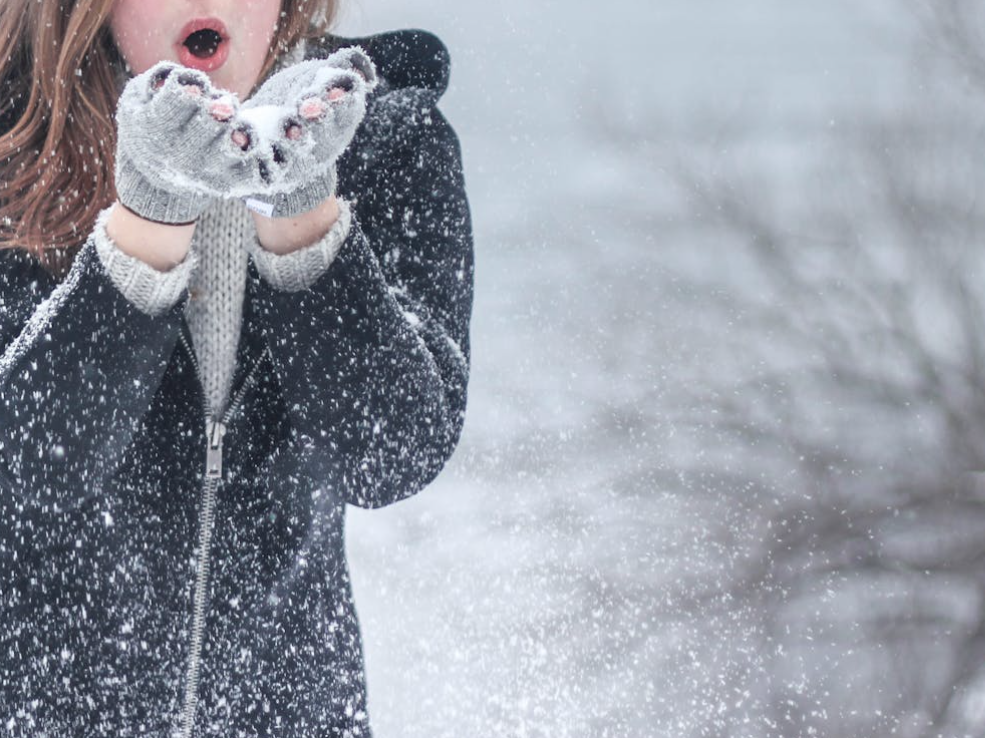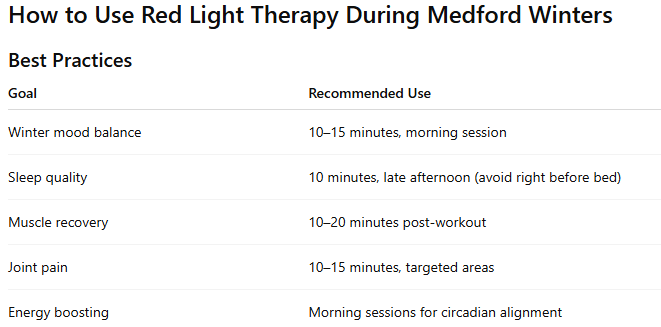Red Light Therapy for Medford Winter Mood and Recovery
Red Light Therapy for Medford Winter Mood and Recovery: A Complete Local Guide for Beating the Winter Blues Naturally
Summary
Medford winters are long, dark, and draining—leading to increased fatigue, low mood, slower recovery, and decreased energy. Red light therapy (RLT), particularly with a clinical-grade LED panel like our Red Light Therapy Panels, has emerged as a powerful science-backed tool for improving mood, boosting mitochondrial energy, supporting seasonal affective symptoms, and accelerating muscle and tissue recovery during the colder months.
Why Medford Residents Struggle More in Winter
Southern Oregon’s winter climate brings:
Limited daylight hours
Low UV exposure
Cold temperatures
Higher indoor time
These conditions contribute to:
Seasonal low mood
Sleep disruption
Reduced serotonin
Slower muscle recovery
Joint stiffness
Chronic fatigue
This combination creates the perfect storm for winter sluggishness—an issue many Medford locals face annually.
Red light therapy directly supports these challenges by addressing mitochondrial function, inflammation, and circadian rhythm balance.
What is Red Light Therapy?
Red light therapy (RLT), also known as photobiomodulation (PBM), uses specific wavelengths of red (630–660 nm) and near-infrared (810–850 nm) light to:
Stimulate ATP production
Reduce inflammation
Enhance cellular repair
Support neurotransmitter balance
Improve circulation
Our Red Light Therapy Panels deliver these wavelengths at safe, therapeutic power levels ideal for home use—and strong enough to rival clinical PBM systems.
How Red Light Therapy Helps Medford’s Winter Mood (SAD Support)
1. Supports Serotonin & Dopamine Balance
Red wavelengths influence neurotransmitter regulation, which may support:
Improved emotional stability
Reduced seasonal mood dips
Enhanced stress resilience
2. Balances Your Circadian Rhythm
Evening darkness arrives early in Medford. RLT helps regulate melatonin cycles, improving:
Sleep quality
Daytime alertness
Morning energy
3. Combats Seasonal Fatigue
By enhancing mitochondrial ATP, RLT may:
Increase natural energy production
Reduce feelings of heaviness or exhaustion
Improve overall vitality during winter months
4. Helps Offset Low-Light Living
While not a replacement for sunlight, red/NIR light:
Helps replicate some natural-light benefits
Supports endocrine function
May reduce the severity of winter blues
Red Light Therapy for Cold-Weather Muscle & Joint Recovery
Medford athletes, hikers, and active adults love RLT because it provides:
✔ Faster Muscle Repair
Promotes recovery from:
Workouts
Overuse
Winter stiffness
✔ Reduced Inflammation
Helpful for:
Joint tightness
Chronic pain flares
Post-injury recovery
✔ Improved Circulation
Warmth-like effects without heat—helpful for cold-season vascular constriction.
✔ Better Tissue Oxygenation
Especially useful for older adults or those with chronic conditions that worsen in cold weather.
Why our Panels are Ideal for Medford Winter Wellness
Clinical-Grade Irradiance
High power density ensures therapeutic light penetrates deeper—ideal for:
Mood regulation
Muscle recovery
Joint health
Dual Wavelength Technology
Our red light therapy panels offer:
Red 660 nm – mood, skin health, inflammation
NIR 850 nm – deep tissue, muscle, joints, mitochondria
Full-Body Treatment
A panel design means large coverage—more effective than handheld devices.
Safe, Non-Invasive & Chemical-Free
Suitable for:
Adults
Athletes
Seniors
Injured individuals
Frequently Asked Questions
Is red light therapy good for seasonal depression or SAD?
While RLT is not a replacement for medical treatment, studies suggest it supports mood-regulating biological pathways that may help reduce winter blues.
How quickly will I feel results?
Many users report improved energy and mood within 1–2 weeks of consistent use.
Can I overuse red light therapy?
More is not always better. Follow recommended exposure times.
Experience the Benefits of Red Light Therapy This Winter
If you’re ready to improve mood, energy, and recovery this winter:
👉 Shop our Selection of Red Light Therapy Panels for Home Use
Get unlimited access to mood and recovery benefits all winter long.
Shop Now → SHOP RED LIGHT PANELS
Scientific References:
Smagula SF, DuPont CM, Miller MA, et al. Rest-activity rhythms characteristics and seasonal changes in seasonal affective disorder. Chronobiol Int. 2018;35:1553–9.
Vandewalle G, Schwartz S, Grandjean D, et al. Spectral quality of light modulates emotional brain responses in humans. Proc Natl Acad Sci U S A. 2010;107:19549–54.
Kaminski-Hartenthaler A, Nussbaumer B, Forneris CA, et al. Melatonin and agomelatine for preventing seasonal affective disorder. Cochrane Database Syst Rev. 2015;11 CD011271.
Sarran C, Albers C, Sachon P, Meesters Y. Meteorological analysis of symptom data for people with seasonal affective disorder. Psychiatry Res. 2017;257:501–5.
Killgore WDS. Lightening the mood: evidence for blue light exposure in the treatment of post-concussion depression. Expert Rev Neurother. 2020;20:1081–3.
Srisurapanont K, Samakarn Y, Kamklong B, et al. Blue-wavelength light therapy for post-traumatic brain injury sleepiness, sleep disturbance, depression, and fatigue: a systematic review and network meta-analysis. PLoS One. 2021;16:e0246172.
Pjrek E, Friedrich ME, Cambioli L, et al. The efficacy of light therapy in the treatment of seasonal affective disorder: a meta-analysis of randomized controlled trials. Psychother Psychosom. 2020;89:17–24.
Schnell A, Albrecht U, Sandrelli F. Rhythm and mood: relationships between the circadian clock and mood-related behavior. Behav Neurosci. 2014;128:326–43.
Kegel M, Dam H, Ali F, Bjerregaard P. The prevalence of seasonal affective disorder (SAD) in Greenland is related to latitude. Nord J Psychiatry. 2009;63:331–5.
Boyce P, Parker G. Seasonal affective disorder in the southern hemisphere. Am J Psychiatry. 1988;145:96–9.
Rosenthal NE. Issues for DSM-V: seasonal affective disorder and seasonality. Am J Psychiatry. 2009;166:852–3.
Chen Z-W, Zhang X-F, Tu Z-M. Treatment measures for seasonal affective disorder: a network meta-analysis. J Affect Disord. 2024;350:531–6.
Obayashi K, Saeki K, Iwamoto J, Ikada Y, Kurumatani N. Exposure to light at night and risk of depression in the elderly. J Affect Disord. 2013;151:331–6.
An K, Zhao H, Miao Y, et al. A circadian rhythm-gated subcortical pathway for nighttime-light-induced depressive-like behaviors in mice. Nat Neurosci. 2020;23:869–80.
Loving RT, Kripke DF, Knickerbocker NC, Grandner MA. Bright green light treatment of depression for older adults ISRCTN69400161. BMC Psychiatry. 2005;5:42.
Seetharaman K, Chaudhury H, Kary M, Stewart J, Lindsay B, Hudson M. Best practices in dementia care: a review of the grey literature on guidelines for staffing and physical environment in long-term care. Can J Aging. 2022;41:55–70.
Min J, Min K. Outdoor light at night and the prevalence of depressive symptoms and suicidal behaviors: a cross-sectional study in a nationally representative sample of Korean adults. J Affect Disord. 2018;227:199–205.
Melrose S. Seasonal affective disorder: an overview of assessment and treatment approaches. Depress Res Treat. 2015;2015:178564.
Lam RW, Levitt AJ, Levitan RD, et al. The can-SAD study: a randomized controlled trial of the effectiveness of light therapy and fluoxetine in patients with winter seasonal affective disorder. Am J Psychiatry. 2006;163:805–12.
Rouse B, Chaimani A, Li T. Network meta-analysis: an introduction for clinicians. Intern Emerg Med. 2017;12:103–11.
Anderson JL, Glod CA, Dai J, Cao Y, Lockley SW. Lux vs. wavelength in light treatment of seasonal affective disorder. Acta Psychiatr Scand. 2009;120:203–12.
Williams J, Link M, Rosenthal N, Terman M. Structured Interview Guide for the Hamilton Depression Rating Scale, Seasonal Affective Disorder Version (SIGH-SAD).1998.
Eastman CI, Young MA, Fogg LF, Liu L, Meaden PM. Bright light treatment of winter depression: a placebo-controlled trial. Arch Gen Psychiatry. 1998;55:883–9.
Anderson JL, Hilaire MA, Auger RR, et al. Are short (blue) wavelengths necessary for light treatment of seasonal affective disorder? Chronobiol Int. 2016;33:1267–79.
Rohan KJ, Mahon JN, Evans M, et al. Randomized trial of cognitive-behavioral therapy versus light therapy for seasonal affective disorder: acute outcomes. Am J Psychiatry. 2015;172:862–9.
Rohan KJ, Roecklein KA, Tierney Lindsey K, et al. A randomized controlled trial of cognitive-behavioral therapy, light therapy, and their combination for seasonal affective disorder. J Consult Clin Psychol. 2007;75:489–500.
Stewart KT, Gaddy JR, Byrne B, Miller S, Brainard GC. Effects of green or white light for treatment of seasonal depression. Psychiatry Res. 1991;38:261–70.
Meesters Y, Dekker V, Schlangen LJ, Bos EH, Ruiter MJ. Low-intensity blue-enriched white light (750 lux) and standard bright light (10,000 lux) are equally effective in treating SAD. A randomized controlled study. BMC Psychiatry. 2011;11:17.
Meesters Y, Duijzer WB, Hommes V. The effects of low-intensity narrow-band blue-light treatment compared to bright white-light treatment in seasonal affective disorder. J Affect Disord. 2018;232:48–51.
Desan PH, Weinstein AJ, Michalak EE, et al. A controlled trial of the litebook light-emitting diode (LED) light therapy device for treatment of seasonal affective disorder (SAD). BMC Psychiatry. 2007;7:38.
Flory R, Ametepe J, Bowers B. A randomized, placebo-controlled trial of bright light and high-density negative air ions for treatment of seasonal affective disorder. Psychiatry Res. 2010;177:101–8.
Gordijn MCM, 't Mannetje D, Meesters Y. The effects of blue-enriched light treatment compared to standard light treatment in seasonal affective disorder. J Affect Disord. 2012;136:72–80.
Magnusson A, Kristbjarnarson H. Treatment of seasonal affective disorder with high-intensity light. A phototherapy study with an Icelandic group of patients. J Affect Disord. 1991;21:141–7.
Terman M, Terman JS. Controlled trial of naturalistic dawn simulation and negative air ionization for seasonal affective disorder. Am J Psychiatry. 2006;163:2126–33.
Oren DA, Brainard GC, Johnston SH, Joseph-Vanderpool JR, Sorek E, Rosenthal NE. Treatment of seasonal affective disorder with green light and red light. Am J Psychiatry. 1991;148:509–11.




